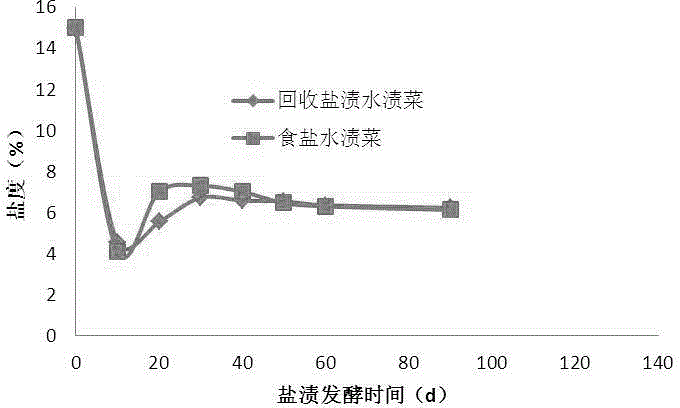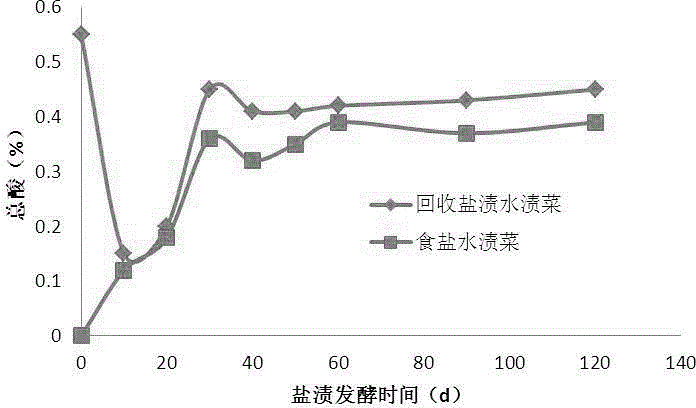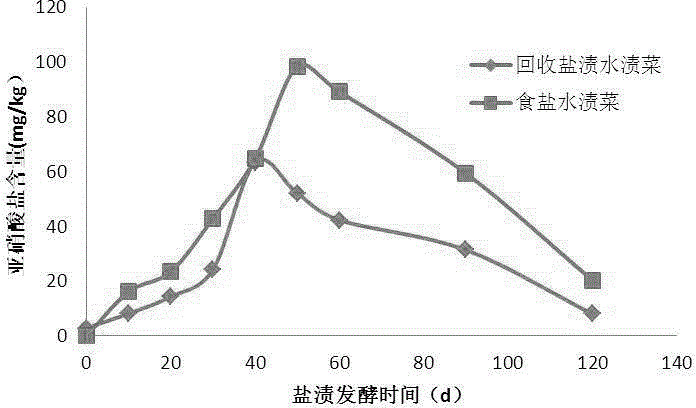Method for preparing pickled cabbage through multiple rounds of salting and fermentation
A fermentation method and kimchi technology, applied in the fields of application, food preparation, food science, etc., can solve the problems of long salt fermentation period, high nitrite content, low lactic acid bacteria content, etc., achieve rapid fermentation and maturity cycle, and high nutritional value , the effect of high solid content
- Summary
- Abstract
- Description
- Claims
- Application Information
AI Technical Summary
Problems solved by technology
Method used
Image
Examples
Embodiment 1
[0046] (1) Filling the pool: Fill the salting pool with fresh vegetables and noodle salt according to the salting process of "one layer of salt and one layer of vegetables". Based on the total mass of salt, first put 5% of the salt into the bottom of the pool, then layer fresh vegetables and salt, and finally add 15% of salt on top of the vegetables after the pool is full. At this time, due to the osmosis of the salt, the vegetables are dehydrated, and the volume occupied by the vegetables in the salting pool shrinks.
[0047] At the beginning, after the vegetables are put into the pond, it is difficult for the salt on the top to penetrate to the bottom. Increase the concentration of the salt below to dehydrate the vegetables at the bottom faster, save space and at the same time make the vegetables on the top settle down faster. Since the fermented vegetable liquid will be continuously produced in the pond, the salt below will be pumped to the top, so that the salinity of the ...
Embodiment 2
[0054] (1) Filling the pool: Fill the salting pool with fresh vegetables and noodle salt according to the salting process of "one layer of salt and one layer of vegetables", and then add enough salt on top of the vegetables. At this time, due to the penetration of salt, the vegetables Dehydration will reduce the volume of vegetables in the salted pool; based on the total mass of salt, first put 4% of the salt into the bottom of the pool, then layer fresh vegetables and salt, and finally add it to the top of the vegetables after the pool is full. 16% salt.
[0055] (2) Secondary feeding: When the acidity of vegetables in the salting pool reaches 0.35%, add fresh vegetables and noodle salt on the top according to the salting process of "one layer of salt and one layer of vegetables", and then add enough salt on top of the vegetables. The fermented liquid after the last fermentation has been recovered and treated to circulate water in the saline pond and seal the pond;
[0056] ...
Embodiment 3
[0060] (1) Filling the pool: Fill the salting pool with fresh vegetables and noodle salt according to the salting process of "one layer of salt and one layer of vegetables", and then add enough salt on top of the vegetables. At this time, due to the penetration of salt, the vegetables Dehydration, the volume occupied by vegetables in the salted pool is reduced; based on the total mass of salt, first put 5% of the salt into the bottom of the pool, then layer fresh vegetables and salt, and finally add to the top of the vegetables after the pool is full 15% salt.
[0061] (2) Secondary feeding: When the acidity of vegetables in the salting pool reaches 0.45%, add fresh vegetables and noodle salt on the top according to the salting process of "one layer of salt and one layer of vegetables", and then add enough salt on top of the vegetables. The fermented liquid after the last fermentation has been recovered and treated to circulate water in the saline pond and seal the pond;
[0...
PUM
 Login to View More
Login to View More Abstract
Description
Claims
Application Information
 Login to View More
Login to View More - R&D
- Intellectual Property
- Life Sciences
- Materials
- Tech Scout
- Unparalleled Data Quality
- Higher Quality Content
- 60% Fewer Hallucinations
Browse by: Latest US Patents, China's latest patents, Technical Efficacy Thesaurus, Application Domain, Technology Topic, Popular Technical Reports.
© 2025 PatSnap. All rights reserved.Legal|Privacy policy|Modern Slavery Act Transparency Statement|Sitemap|About US| Contact US: help@patsnap.com



